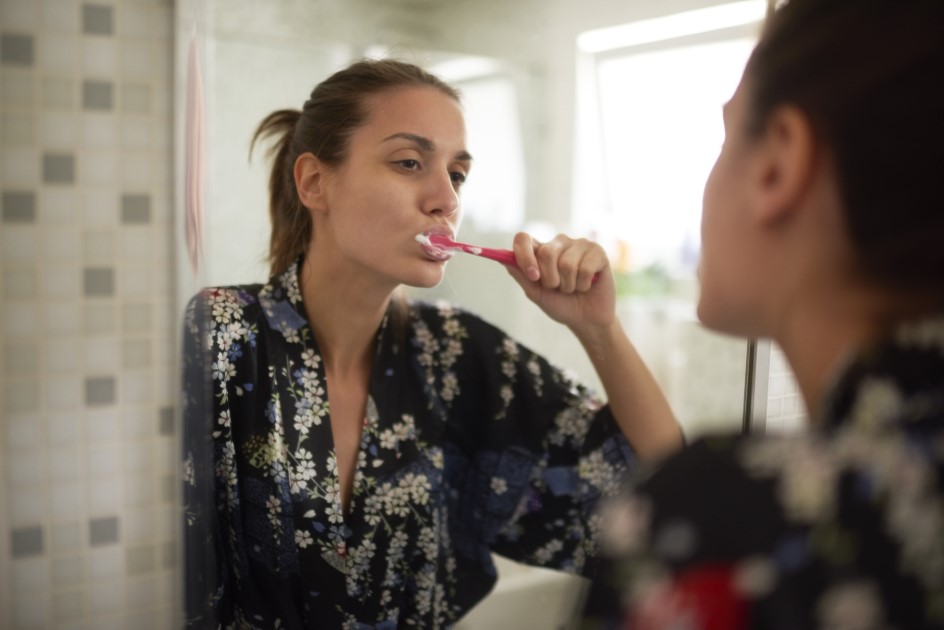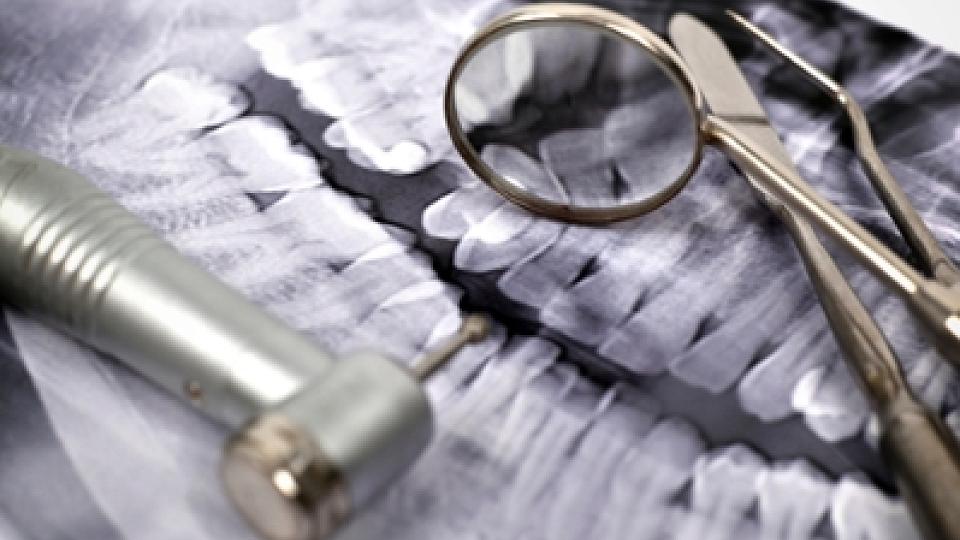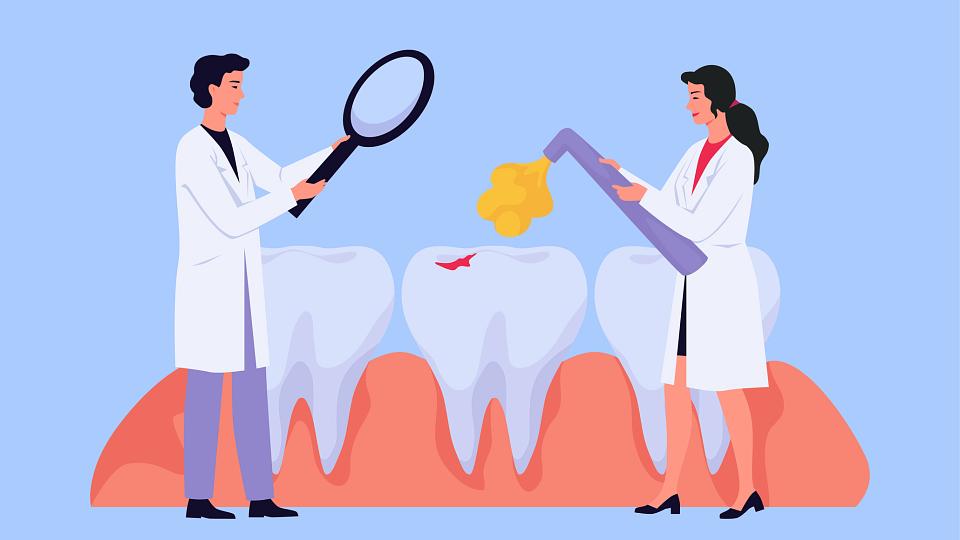
Interviewer: Brushing your teeth is just one of those things we've done most of our lives and probably don't think too much about it, but we're learning new things about health every day. How you brush, when you brush, and other factors can play a big part in making you more effective at avoiding issues like damage to tooth enamel, receding gum lines, and other potentially serious oral health concerns.
Dr. Arman Farhadtouski specializes in dentistry at University of Utah Health. And he's going to share some information that could change the way you brush your teeth. So my very first question is, how should I be brushing my teeth?
Proper Teeth Brushing Techniques
Farhadtouski: As far as what are the appropriate motions or how we should brush, the way I approach this with my patients is I ask them to use several different types of motions in a systematic approach, where they start from one part of the mouth and they go around in a circle and end up at the other part of the mouth. And they kind of make a full circle. What I ask them to do is I essentially ask them to start by brushing all of the tooth surfaces that they can see, the chewing surfaces, the sides, especially the very back surface of the backmost teeth in the mouth. A lot of times patients skip these parts.
After that, once they are able to clean all the chewing surfaces, I also ask them to angle their toothbrush tilted slightly, you know, close to 45 degrees, and have them focus a little bit of their effort right at the gum line. There are little curvatures, inward curvatures that teeth naturally have that are present right at the gum line. And these are the places where plaque can accumulate. The way cavities form is if you have bacteria or plaque, which is consistent with bacteria sitting in a place for a long time and it's undisrupted, then that's how you get a cavity. So the point is to try to get as much of the plaque biofilm off as possible.
Now, with that said, when you consider what the proper motion is, you know, smaller circular motions or what have you, I don't necessarily think that there is a one-size-fits-all solution to this question. There are a lot of unique patient factors that have to be taken into consideration. For example, if an individual has crowding of teeth, or misalignment, or perhaps a type of dental prosthesis that's fixed in the mouth, they may have to adjust the way they hold the toothbrush in that one specific area, and that in itself may impact their approach.
So what I really like to do, and I've found this to be a very impactful patient education tool, is I highly recommend my patients allow me to send them home with some disclosing tablets. These are essentially dye solutions that bind to specific proteins in the bacteria. And they can show you where the bacteria are on your teeth. And I ask the patients to just chew the tablet, brush, and just take a look. And that visual feedback for them is more powerful sometimes than any amount of time I can spend showing them how to brush. So I really like to have the patients be active participants in that part of the education and how we come to a solution that works best for their unique patient needs. And so that's how we kind of tackle the question of the proper motion when brushing.
Interviewer: So I thought that maybe the proper motion also had something to do with, you know, making sure I wasn't damaging my gums because I've gone to the dentist before and they say, "How are you brushing because you're starting to get some receding gums."
Farhadtouski: Absolutely. That is a perfect transition because we want to talk a little bit about it too, and patients naturally have this question. "Well, what is an appropriate amount of force? And what type of toothbrush should I be using?" There are so many different types of toothbrushes.
Choosing the Right Toothbrush
So, as far as the toothbrush, I recommend using a soft bristle toothbrush and using just mild force. And what do I mean by that? Because that's a very subjective thing. If we are consistent with our oral hygiene and our dental visits, the plaque that's remaining on the teeth and what we are trying to remove by daily brushing should be very soft. We should not have to use a lot of force to remove that plaque. And that's where utilizing this disclosing tablet is, again, another excellent educational tool because I can have the patient chew the disclosing tablet and they can see in real-time how much force they need to utilize to disrupt the plaque biofilm that has formed on their teeth.
And as far as your toothbrush, I also have patients ask me, "Hey, how often should I be replacing this? How long is it good for? What should I look for?" I typically recommend that my patients change their toothbrush every three months. However, there are some that may suggest every three to six months. I wouldn't recommend any more than six months. And if you find that your bristles are starting to get curled and they're not as effective, then that may also be a good indication that you are due for a new toothbrush.
Impact of Brushing on Gum Health
Interviewer: And then as far as gum health, that really doesn't have anything with if I'm using small circular motions or back and forth. That really has to do with how hard is the brush and how hard am I pressing. Is that correct?
Farhadtouski: Yes and no. So there is some element, some part of our brushing can contribute to gum health. When we ask patients to tilt their toothbrushes 45 degrees and kind of brush at the gum line, in a way we are helping remove the plaque that can form in natural spaces that we have between our gums and our teeth. And this plaque bacteria may be underneath the gums, and so it's not visually present. So when we modify our brushing and utilize that technique as well, we are contributing to overall gum health.
Interviewer: All right. And just to be straight, say I've got my toothbrush in my mouth and I've got it on my upper teeth. In that 45-degree turn, the bristles would turn up toward the sky or down toward the ground. I have a feeling it's up.
Farhadtouski: Yeah. So for your top teeth, it will point towards the sky. And the way you know you're doing it right is if you feel the bristles rubbing against your gums. You should . . .
Interviewer: And that's okay.
Farhadtouski: Yeah. And that's okay. That means you're in the right place doing the right job. Now, it shouldn't be extremely painful. With some patients, if oral hygiene has been a little bit of a challenge and there's a little bit more inflammation, they may notice a little bit more bleeding. They may notice a little bit of sensitivity. But again, this is not painful. If done with appropriate technique and if you follow your oral health provider's instructions, there is no damage that you can do.
When and How Often You Should be Brushing Your Teeth
Interviewer: So we've learned how we should brush. And those tablets sound like they'd be pretty cool to ask your dentist if you could have some, if you have any questions if you're doing it right. But how often should somebody brush?
Farhadtouski: What I recommend is I ask my patients to brush first thing in the morning when they wake up before they have had any food. They can have water. But I ask them to brush with toothpaste that contains fluoride and wait for about 20 to 30 minutes before eating anything.
After you eat, now this can be for breakfast, for lunch, or for a late dinner, I ask patients to not use toothpaste if they decide to brush their teeth right after eating. Without getting too much into the specifics, it's just important to note that eating food and just having food in your mouth can change the chemistry of the mouth, and it can make the enamel more greatly impacted by the abrasive particles in our toothpaste. So if you have food debris in your mouth after eating, you have to get it out, just I recommend either swishing vigorously with just water or just brushing with just water.
Then I ask you to go throughout your whole day and do everything as normal. And about two hours or so before you go to bed, I ask you to stop eating except water. And that's because I want to allow the oral environment to be stabilized again so that we don't have negative impacts from the abrasive particles in toothpaste. Then after those two hours, you're getting ready for bed, I ask my patients to floss first with the appropriate technique that we show them at the office and rinse with water so we get all the debris that's been dislodged out. And then again, brush with the fluoride-containing toothpaste. And wait 20 to 30 minutes before . . . Well, hopefully, you're not eating at this point. And this should be the last thing you do. You can drink water, but that's about it.
Interviewer: Yeah. I was surprised to find out last time when I went to the dentist that what you just told me, that like I always learned you brush after you eat breakfast before you go out and start your day. You know, you brush after supper, and then maybe you brush before bed. But you're really saying try not to brush after you've eaten. I've also heard that drinking coffee or tea can also change that mouth chemistry.
Farhadtouski: Absolutely. Absolutely. I want to make sure that we don't get lost too much in the science of what happens, but let's give a little bit of a better explanation of what happens. As you mentioned, the oral environment is very dynamic. Foods that are acidic or basic can change that environment and tilt it in one direction or the other. The ideal place for the mouth and for oral health to be is that neutral zone. And so when we do eat, that change into these zones outside of the neutral zone is very fast. Now, the body has a built-in mechanism to restabilize it, but that change is very slow.
When we eat, we very rapidly change the oral environment to something that can impact the enamel adversely, and then very slowly it comes back to that baseline. The routine that I recommend and the recommendations I give to patients take this into consideration. And when patients do ask those follow-up questions, that's when I can really engage them in the why behind what I'm recommending. And that's where we tend to get better and better compliance.
Choosing the Right Toothpaste
Interviewer: All right. Finally, what about toothpaste? I go into the aisles to buy toothpaste, and there are so many different options. I never know which one should I ultimately pick. What's your advice there?
Farhadtouski: There are things that I ask my patients to stay away from. I don't love abrasive, super abrasive toothpaste, or the charcoal toothpaste that sometimes is advertised to have a whitening property. I think those actually tend to be . . . really could have the potential of really damaging our teeth. It kind of goes back to the topic of having abrasive things wearing away surface enamel. And so those are the types that I ask most folks to stay away from right off the bat.
The other distinction that I ask my patients to make when they're doing their shopping and doing a little bit of research, is to ensure that your toothpaste doesn't specifically say that it does not contain fluoride. Nowadays, most toothpaste contains fluoride. So the ones that don't actually have to advertise that they don't. So that's how you know the distinction. I ask my patients to use fluoride-containing toothpaste. Sometimes, for some folks, I prescribe a type of toothpaste that has a little bit of extra fluoride in there.
But that's really it. There is not one brand that's perfect. But there are certain companies that make a lot of dental products that are very common that you guys probably know the names of, and those are pretty good. I think as long as your toothpaste doesn't have super abrasive particles, like the charcoal kind, and it is not missing fluoride, I don't think you can go wrong. It's really the technique and the consistency and the discipline of the individual that make those big differences.
5 Health Concerns Associated with Gum Disease You May Not Know About
Daniel Thunell, DMD, board-certified periodontist, explains how inflammation in your mouth could impact your long-term wellness—and what you can do to prevent it.
How to Access Affordable Dental Care
Dental health is crucial, but not always affordable for all budgets. James Bekker, DMD, from University of Utah School of Dentistry, offers an insider's guide to finding and utilizing low-cost dental services.
Understanding Tooth Sensitivity and How to Manage It
Feeling discomfort when eating hot or cold foods? Tooth sensitivity can be more than just a minor annoyance—it could signal a deeper issue. David Okano, MD, breaks down what different...







